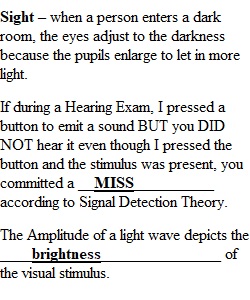


Q Please answer the following questions and submit them in Blackboard for grading. 1. Give one example of Sensory Adaptation. 2. If during a Hearing Exam, I pressed a button to emit a sound BUT you DID NOT hear it even though I pressed the button and the stimulus was present, you committed a ____________ according to Signal Detection Theory. 3. The Amplitude of a light wave depicts the ___________________ of the visual stimulus. 4. Give a brief description of the iris, cornea, lens, and retina, respectively. a. Which part of the retina is associated with night and peripheral vision? 5. Briefly describe the difference between bottom-up and top-down visual processing. a. What type of visual processing is Feature Analysis an element of? 6. What is a simple definition of a "reversible figure"? WHAT IMAGINE DID YOU SEE IN BOTH PICTURES???? I'm just curious! 7. What is the example used for Gestalt's Proximity and Simplicity principles, respectively? 8. What does the Wavelength of a sound wave indicate? 9. What is the "hearing part of the ear"? 10. Name the 5 basic tastes. 11. What are the receptor cells for smell called? 12. List (in linear order) the Touch pathway from tactile to cortex/lobe.
View Related Questions